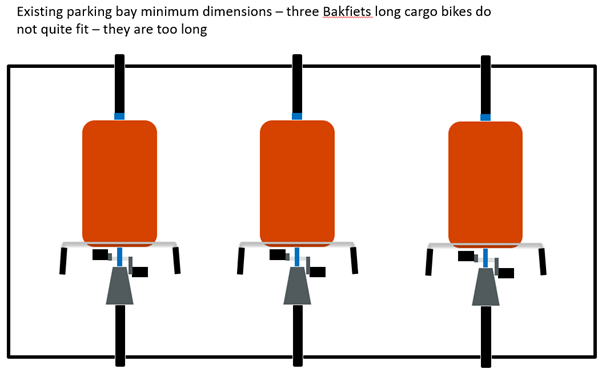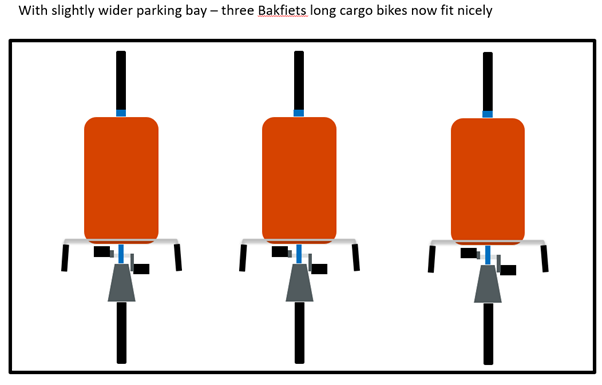A recent Times article, already commented on amply by Glen Lyons on LinkedIn has noted that in order to keep up with increases in car size, ministers are considering a plan to increase the size of parking bays from their current 2.4m x 4.8m minimum. In his post, Glen kindly asked readers to please point out any positives with this plan, as he was worried that he had been too quick to fail to find any.
Coincidentally, a day before I had watched this YouTube video on the 'Bakfiets' cargo bike, which makes a case that this design and others like it can be a genuine car replacement. I had already noted that the length of this bike (2.5m) made it unlikely to fit sensibly into our house's half-sized garage without some serious rearranging and clearing out (mainly of our other bikes).
The current parking bay minimum width (2.4m) is just too small for the length (2.5m) of one of these cargo bikes. There it is – the positive. Here is the diagram I posted in a comment on Glen's post, with some additional context. Apologies for my 'thrown together in PowerPoint shapes' artwork, but it was what I had available, and my artistic abilities are about at this level. The dimensions are to scale, at least. The view is from the top – looking down on a standard size parking bay or a slightly bigger one, with three cargo bikes.


There you go. With slightly larger parking bays, we can fit three such cargo bikes in, and make the whole parking experience a little more pleasant for those using the bay, and those using the space around it. Obviously, this is not a designed solution. It is just making a point.
Overnight, I started to think about the fundamental question here more widely as it relates to transport. At its core, many of the considerations around transport and liveability in public space comes down to two things. The first is how much room things need, and the other is how those things interact with other things in the environment (the speed they move at, whether this is compatible with the mix of traffic and the infrastructure and so-on). I have commented on speed before but it struck me that I have never thought properly about the issue of space; hence this short article.
How much space is it reasonable for us to expect to be provided for our 'transport stuff' when we leave it in public spaces? This, in essence, is what the parking bay issue is about. When we take any personal mode of transport somewhere, there is a need for it to be stored while not in use. This applies equally to my Volvo XC90 squeezed into a standard parking bay, to my future Bakfiets cargo bike taking up one third of a newer (slightly wider) one, and even to my Brompton folding bike stored next to me on the train. We all need space to leave our 'transport stuff'. But how much is reasonable? This is a much more difficult question to answer definitively, but some case studies and thought experiments will help.
The question is clearly accounted for in public space design; we would not have a minimum size for parking bays if there was not some expectation of what is reasonable for a car driver to require when leaving their vehicle while not using it. For non-motorised transport on buses and trains, a similar set of expectations seem to be in place. For example, it can be deemed unacceptable to take up too much space with your bike (folding bikes only at peak times on many London trains, for example). Transport stuff for young humans (prams) and for those with physical needs (wheelchairs for example) also take up space, and there are usually areas reserved for such things on buses.
What about much larger vehicles? I would argue that the expectations about what is reasonable change with perceived need. Someone driving a very large van as part of their business (plumbers, builders, delivery drivers and so-on) would clearly be seen as legitimately needing more space to park if it was their only mode of transport. To go all 'straw man' for a moment though, it seems unlikely that someone who chose to drive an HGV everywhere just because they liked it would enjoy much public support. But what about someone who drives a very large, comfortable 4x4? Is it fair for someone like this to 'expect' more space at their destination? What if they only have a larger vehicle because of a lack of choice – because the vehicles available are all bigger, as part of the slow increases in size seen industry-wide?
The issue becomes even more charged when we consider not just parking bays, but transitory environments such as kerbside locations. Vans stopped and blocking lanes of traffic while delivering to a home. Lorries unloading to shops. Cars parked to allow someone with a disability to alight, or just because the driver wanted to take a phone call. Cargo bikes parked on the footway. All have a mix of space needed, and legitimacy received.
When one reads newspaper articles on things like parking, one gets the impression that everyone is very set in a way of thinking, and that there is a real 'battle' between camps. As it turns out however, when proper research is done such as this article from the British Parking Association people prove to have nuanced feelings on the matter. That article even notes that the 'parking public' show support for active travel (walking, cycling) from spaces more distant from destinations, to support air quality and other improvements.
Which probably brings me back to my original point (and likely Glen's). The future of transport should certainly not be about bigger cars. It should not even be about cars. If all we end up with is the same number of cars, but electric, we will have failed to embrace an opportunity to make transport truly sustainable.
The future of transport should be about integrated systems of mobility that enable people to move around as well as they can, given the space and other resources available. HGVs and vans? Absolutely. Some cars? Sure. Buses? Yep. And cargo bikes definitely fit in there somewhere.

